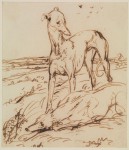Taking its title from a series of drawings and prints by Henry Alken depicting sketches of country life, Scraps: British Sporting Drawings from the Paul Mellon Collection features drawings and watercolors that showcase the passing moments of observation that comprise the rich world of British Sporting Art. Works in the exhibition range from pencil sketches which record the artist’s direct observation of animal subjects to more highly finished works which present a more fully developed vision of sport and country life.
Free admission to this exhibition is supported by the Paul Mellon Endowment.
This exhibition has been organized by the Virginia Museum of Fine Arts and curated by Corey Piper, Curatorial Associate for the Mellon Collections.
The exhibition offers a broader view of artists well known for their sporting paintings and prints such as Henry Alken, James Seymour, Sawrey Gilpin, Edwin Landseer, James Ward and Thomas Rowlandson and reveals them to be skilled draftsmen as well as keen observers of the natural world and the realm of sport. Drawn entirely from the extensive holdings of works on paper in the Mellon Collection at VMFA, this exhibition offers a rare look into the working methods and personal vision of Britain’s greatest sporting artists.
This exhibition takes its title from Scraps, a series of Henry Alken drawings that capture many different moments of country and sporting life. Alken was perhaps history’s most prolific sporting artist, producing many thousands of sporting prints, paintings, and drawings, several of which appear in this exhibition (and hundreds more in the Mellon Collection). Alken belonged to an accomplished family of artists. He distinguished himself through his exceptional graphic skill, perhaps owing to his early training as a miniaturist, and gained popularity thanks to the marketability of his subjects and his staggering output. An avid sportsman himself, Alken first published works under the pseudonym Ben Tally Ho. The drawings in this exhibition from Scraps and from Landscape Scenery, another Alken series, showcase the artist’s popular anecdotal style in which he captures the fleeting and often-comical episodes of life in the country.
The exhibition is divided into three sections, the first of which features artists’ depictions of animals. Most sporting artists during this period adhered to an academic tradition that emphasized drawing from studio models. However, the influence of the Romantic movement and scientific principles of the Enlightenment led many outdoors to draw directly from nature. In this exhibition, examples of artists’ direct observation of animals in nature can be found in many works, including Peter De Wint’s watercolor studies of cattle and Edwin Landseer’s pen drawing of greyhounds during a break in the hunt. Domesticated animals, such as the horse, offered artists ample opportunity for prolonged study, as seen in James Seymour’s carefully delineated pencil drawing that pays equal attention to both the precise proportions of the racehorse as well as the meticulous details of the saddle. Depicting prey animals (an important subject of sporting art) often required an artist to compose drawings based on fleeting observations, as in Samuel Howitt’s image of a frantic hare.
In addition to cultivating a keen understanding of animal subjects, sporting artists also spent many hours observing humans engaged in sports and, as both participants and spectators, developed an intimate knowledge of field sports and sporting life. Examples of artists’ direct observations of human subjects can be seen in Harden Melville and Henry Alken’s pencil and watercolor studies of riders and their mounts. There was heavy demand for images of sporting subjects not only among the wealthy who participated in these pursuits but also among middle-class and urban clientele for whom such depictions stoked nostalgia for country living and reinforced their sense of national identity. Sporting drawings served as both models for prints, as seen in examples by Henry Alken and Samuel Howitt, and as unique compositions for sale, as was likely the case for Robert Marris’s view of riders in Hyde Park and several other works seen here. The rich tradition of humor that pervades sporting art is evidenced in several satirical depictions of sporting characters and mishaps by Thomas Rowlandson and Henry Heath.
From its heyday in the late 18th and early 19th centuries and beyond, coaching was a much-loved subject among sporting artists and their public. While popular for its picturesque or nostalgic subject matter, such imagery also celebrated coaching as a transportation revolution that, with its network of roads and stopping places, fundamentally changed the countryside throughout Britain. The modernization of transport shrank travel times drastically, allowing for freer movement of people and information throughout the country. In light of the important role coaching played in the history of Britain, it is little surprise that artists portrayed the subject with such frequency. Artists such as Charles Cooper Henderson and Henry William Bunbury offer a documentary view of the world of road travel–depicting the characters, equipment, and animals that kept the system running. In more finished compositions, Thomas Rowlandson and Samuel Howitt express the romantic vision of coaching, which came to dominate depictions of the subject. Inspired by nostalgia, later 19th-century artists continued to produce depictions of coaching long after it was replaced by the railroad.
Event Has Concluded






